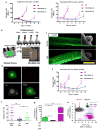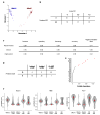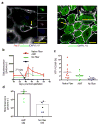An artificial niche preserves the quiescence of muscle stem cells and enhances their therapeutic efficacy
- PMID: 27240197
- PMCID: PMC4942359
- DOI: 10.1038/nbt.3576
An artificial niche preserves the quiescence of muscle stem cells and enhances their therapeutic efficacy
Abstract
A promising therapeutic strategy for diverse genetic disorders involves transplantation of autologous stem cells that have been genetically corrected ex vivo. A major challenge in such approaches is a loss of stem cell potency during culture. Here we describe an artificial niche for maintaining muscle stem cells (MuSCs) in vitro in a potent, quiescent state. Using a machine learning method, we identified a molecular signature of quiescence and used it to screen for factors that could maintain mouse MuSC quiescence, thus defining a quiescence medium (QM). We also engineered muscle fibers that mimic the native myofiber of the MuSC niche. Mouse MuSCs maintained in QM on engineered fibers showed enhanced potential for engraftment, tissue regeneration and self-renewal after transplantation in mice. An artificial niche adapted to human cells similarly extended the quiescence of human MuSCs in vitro and enhanced their potency in vivo. Our approach for maintaining quiescence may be applicable to stem cells isolated from other tissues.
Conflict of interest statement
The authors declare no competing financial interests.
Figures






Comment in
-
Stem cells: Engineering an artificial niche for cell quiescence.Nat Rev Mol Cell Biol. 2016 Jun 22;17(7):398. doi: 10.1038/nrm.2016.82. Nat Rev Mol Cell Biol. 2016. PMID: 27329965 No abstract available.
Similar articles
-
The mini-IDLE 3D biomimetic culture assay enables interrogation of mechanisms governing muscle stem cell quiescence and niche repopulation.Elife. 2022 Dec 20;11:e81738. doi: 10.7554/eLife.81738. Elife. 2022. PMID: 36537758 Free PMC article.
-
Tubastatin A maintains adult skeletal muscle stem cells in a quiescent state ex vivo and improves their engraftment ability in vivo.Stem Cell Reports. 2022 Jan 11;17(1):82-95. doi: 10.1016/j.stemcr.2021.11.012. Stem Cell Reports. 2022. PMID: 35021050 Free PMC article.
-
Hypoxia promotes satellite cell self-renewal and enhances the efficiency of myoblast transplantation.Development. 2012 Aug;139(16):2857-65. doi: 10.1242/dev.079665. Epub 2012 Jul 4. Development. 2012. PMID: 22764051 Free PMC article.
-
Plasticity of the Muscle Stem Cell Microenvironment.Adv Exp Med Biol. 2017;1041:141-169. doi: 10.1007/978-3-319-69194-7_8. Adv Exp Med Biol. 2017. PMID: 29204832 Free PMC article. Review.
-
SMART approaches for genome-wide analyses of skeletal muscle stem and niche cells.Crit Rev Biochem Mol Biol. 2021 Jun;56(3):284-300. doi: 10.1080/10409238.2021.1908950. Epub 2021 Apr 7. Crit Rev Biochem Mol Biol. 2021. PMID: 33823731 Review.
Cited by
-
Stem Cell Quiescence: Dynamism, Restraint, and Cellular Idling.Cell Stem Cell. 2019 Feb 7;24(2):213-225. doi: 10.1016/j.stem.2019.01.001. Cell Stem Cell. 2019. PMID: 30735649 Free PMC article. Review.
-
Insight into muscle stem cell regeneration and mechanobiology.Stem Cell Res Ther. 2023 May 12;14(1):129. doi: 10.1186/s13287-023-03363-y. Stem Cell Res Ther. 2023. PMID: 37173707 Free PMC article. Review.
-
Characterization and isolation of highly purified porcine satellite cells.Cell Death Discov. 2017 Apr 10;3:17003. doi: 10.1038/cddiscovery.2017.3. eCollection 2017. Cell Death Discov. 2017. PMID: 28417015 Free PMC article.
-
Multitasking muscle: engineering iPSC-derived myogenic progenitors to do more.Front Cell Dev Biol. 2025 Jan 22;12:1526635. doi: 10.3389/fcell.2024.1526635. eCollection 2024. Front Cell Dev Biol. 2025. PMID: 39911186 Free PMC article.
-
The mechanosensitive ion channel PIEZO1 promotes satellite cell function in muscle regeneration.Life Sci Alliance. 2022 Nov 29;6(2):e202201783. doi: 10.26508/lsa.202201783. Print 2023 Feb. Life Sci Alliance. 2022. PMID: 36446523 Free PMC article.
References
-
- Montarras D, et al. Direct isolation of satellite cells for skeletal muscle regeneration. Science. 2005;309:2064–2067. - PubMed
Publication types
MeSH terms
Substances
Grants and funding
LinkOut - more resources
Full Text Sources
Other Literature Sources

